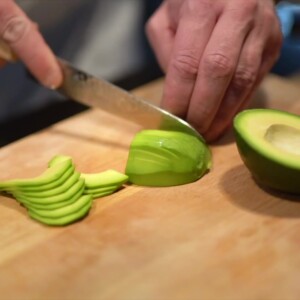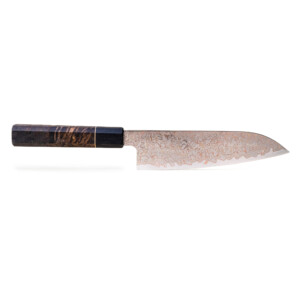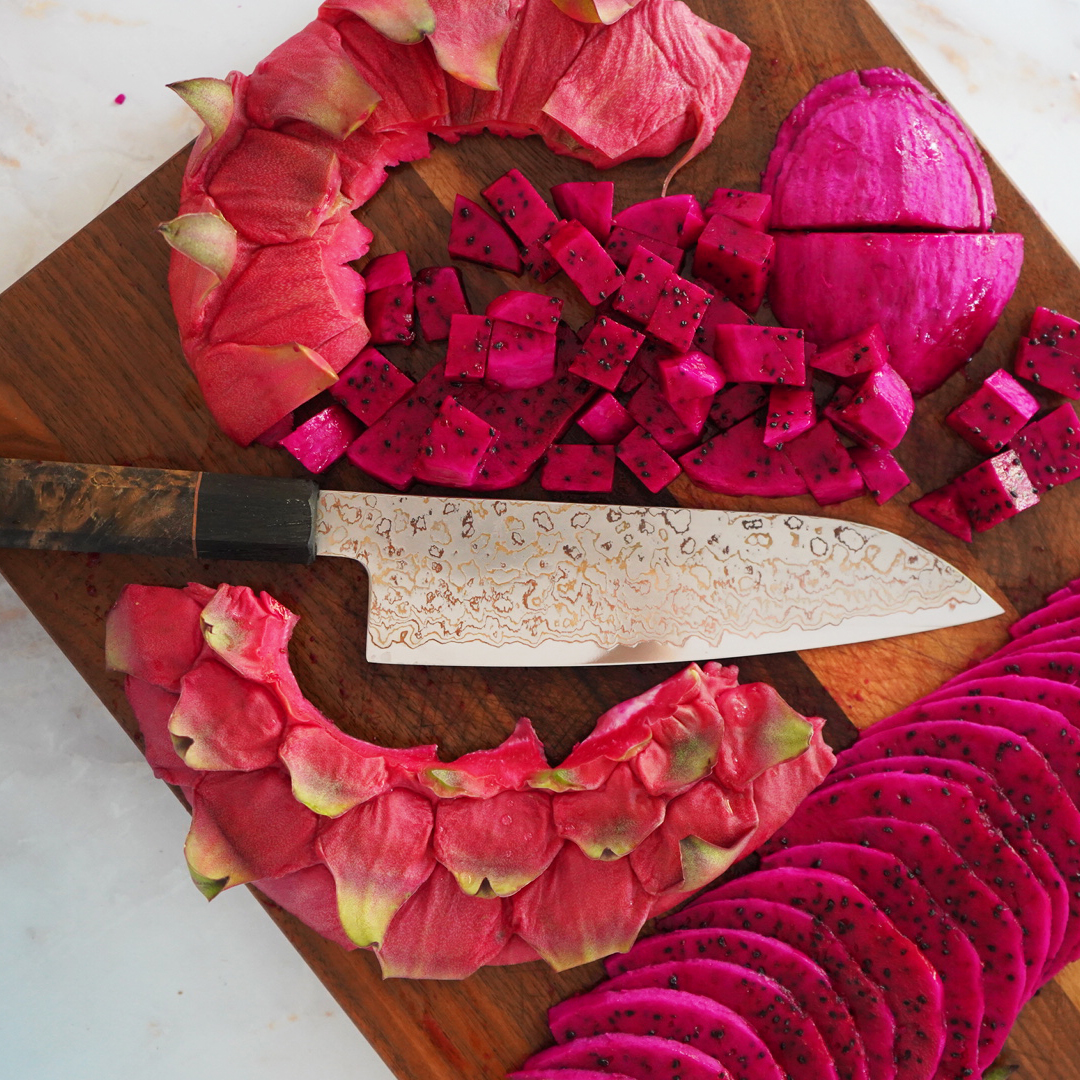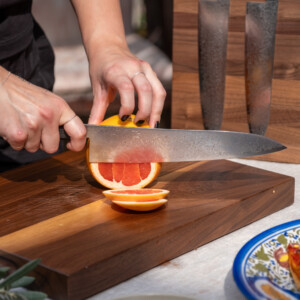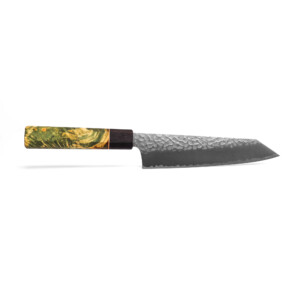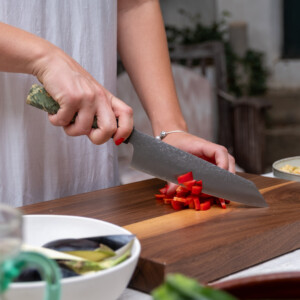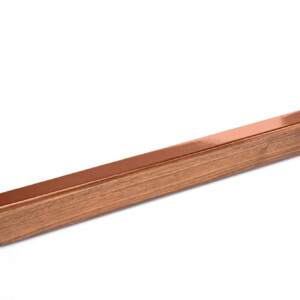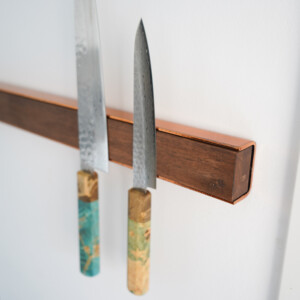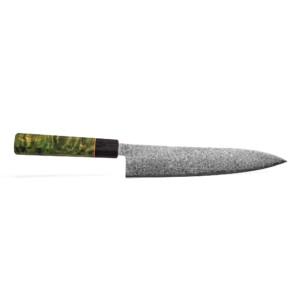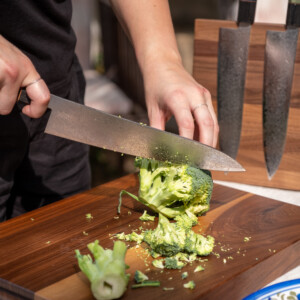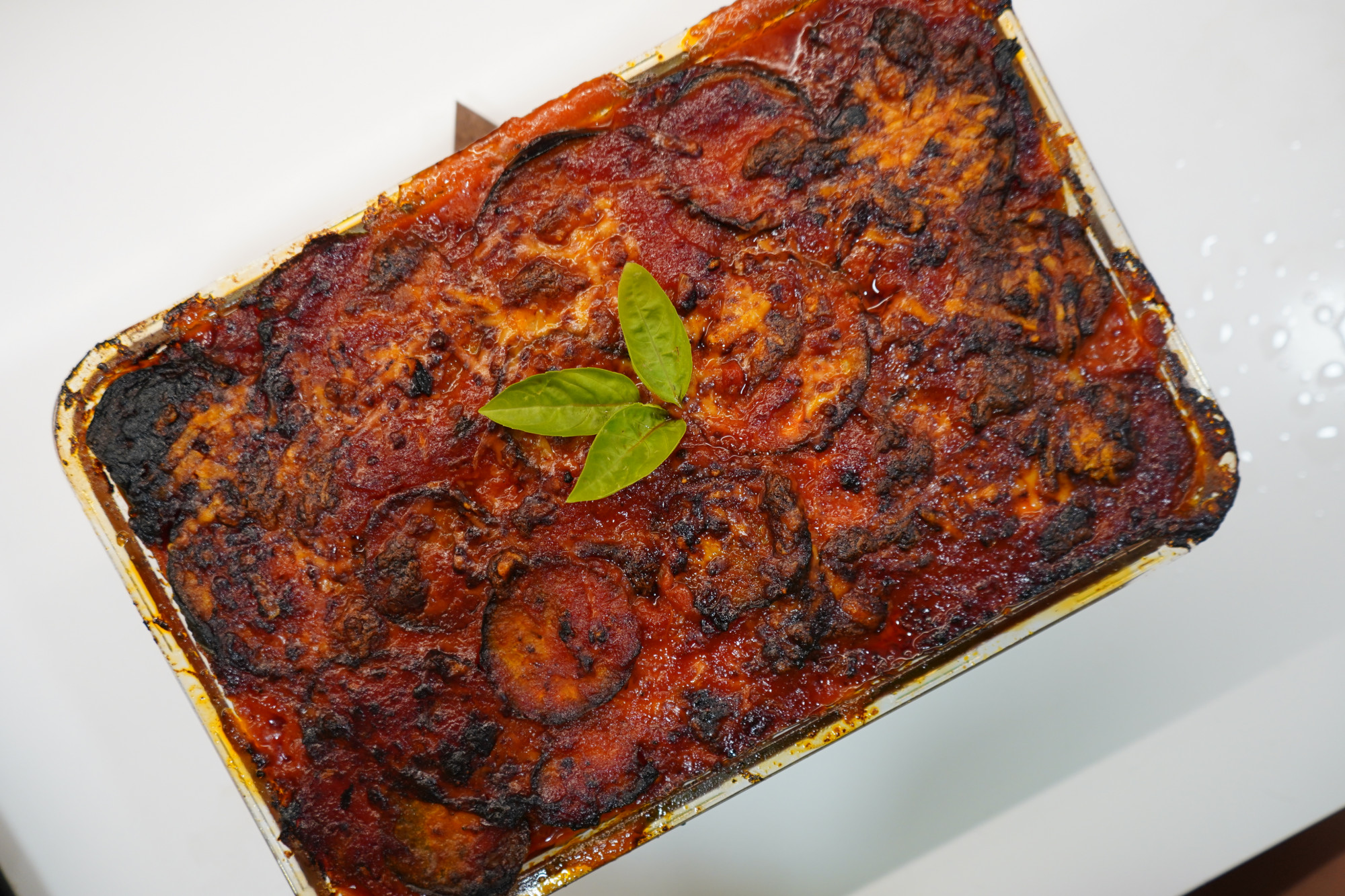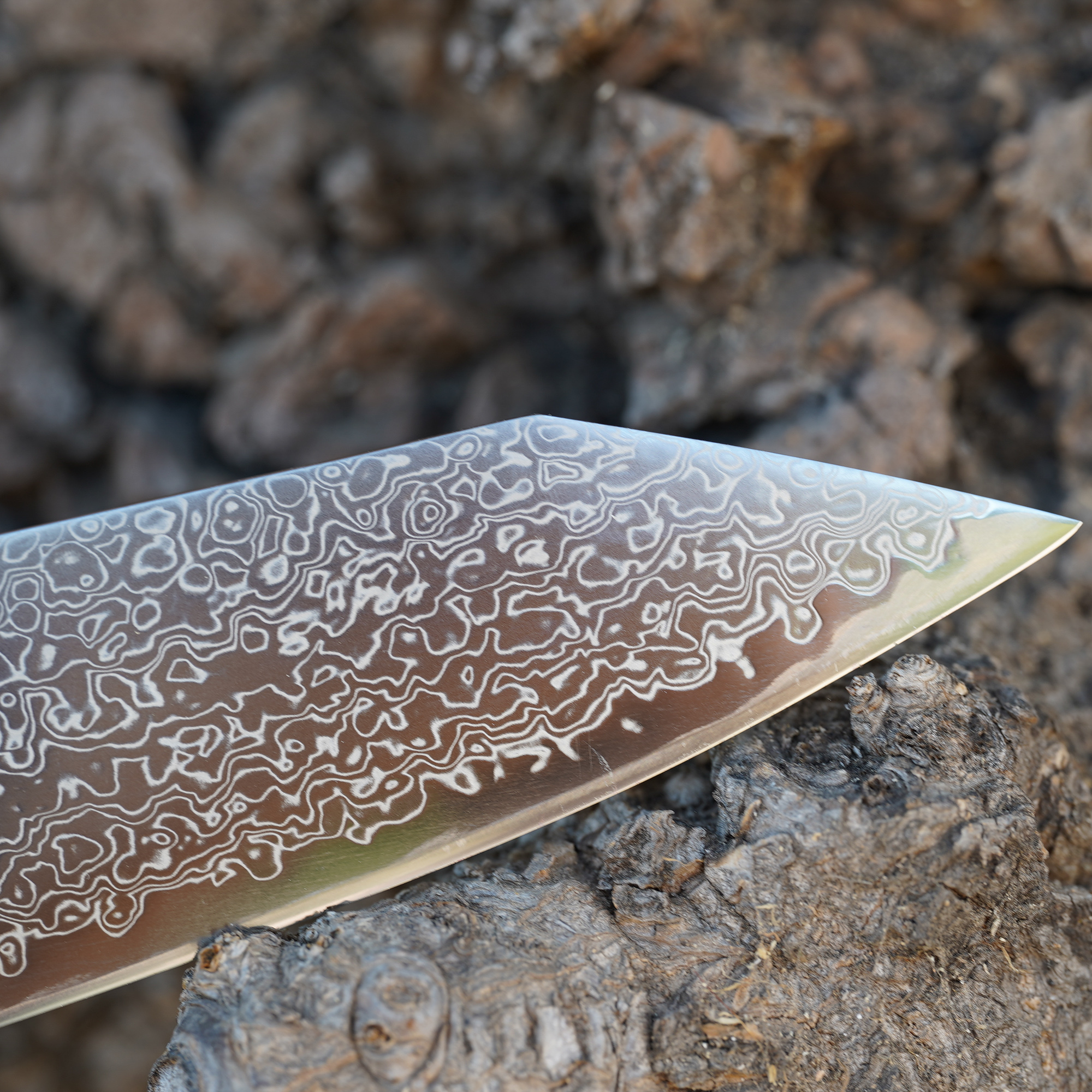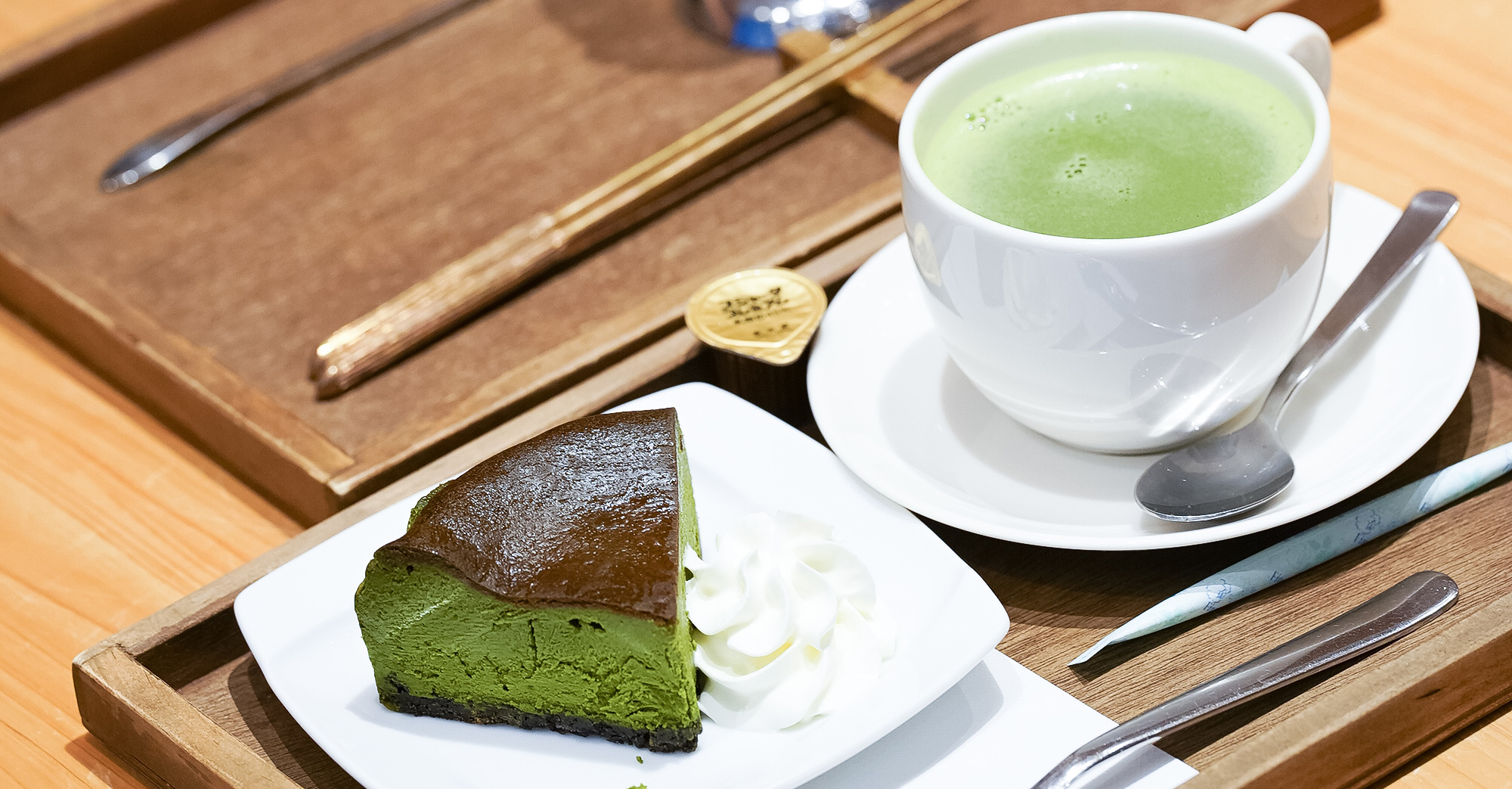Kumihimo roughly translates into English as ‘braided cord’. The word represents, in a larger sense, one of the least known of the traditional arts and crafts of Japan. Due to a cord’s small, inconspicuous presence, it is often overlooked, even in discussions related to a kimono dress. Yet, you can find professionals in Tokyo who live on only by plaiting those cords. The obi, a wide 5 m (15’) long sash, is a substantial component to kumihimo. An obijime is required to hold the obi, and everything underneath it, in place, Obijime are usually narrow braided belts, 2.5 m (7.5’) in length.
Very little is known about the history of Kumihimo. Braids are only one small part of the textile tradition and generally were considered insignificant, hence its documentation was not encouraged. Complex patterns and techniques were passed on verbally in order to keep them secret among family members or guilds, a tradition still practiced by some of the kumihimo schools today.
Kumihimo and its part in Samurai armour
Braiding developed as part of the manufacture of Samurai warrior armour, helmets and knotted sword handles. The robust braiding techniques, capable of producing materials that could withstand fierce fighting, have been passed down through generations and today’s skilled craftsmen keep this technique beautiful as ever.
During the Kamakura period (1185 – 1333 A.D.) and through the Muromachi period (1333 – 1573 A.D.), the warrior class samurai became influential and the demand for armour significantly increased, creating yet another clientele for the kumihimo makers. An amor contains many lacquered iron plates, which are joined by braided ribbons. A suit of armour required approximately 250 – 300 m (280 – 300 yds.) of braid. Pictured at right is an armour maker.
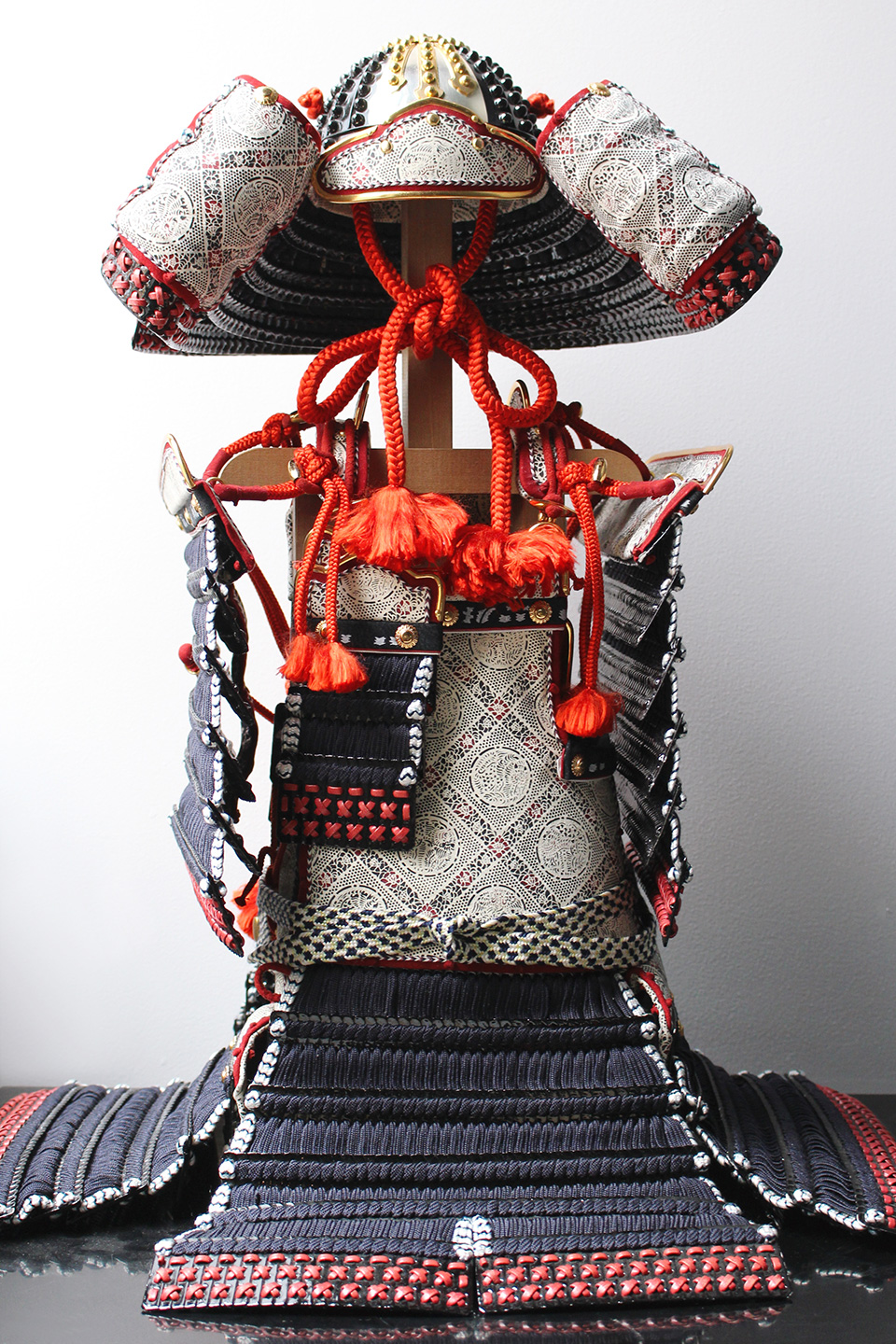
Kumihimo was used extensively for wrapping sword handles (better grip) and also to make armour for horses. Much of the cord, used to connect the leather armour plates, was created in a single colour, with border cords and sword cords showing patterns. A popular design was the ”kikko” (turtle) motif – the symbol for long life. Samples are shown in photo at right.
The period of serious development for today’s common form of kumihimo began in the Nara period (645 – 784 A.D.). Patterns were created in a palette that consisted of lilac, magenta, blue, green, gold, and an orange specially imported from China. This combination was considered powerful enough to banish evil ghosts. There was a saying that women who wear a belt of these ”Shoso-in colours” are protected against bad luck.
During the Heian period (784 – 1184 A.D.) Buddhism became the dominant religion in Japan, opening up a vast market for braiders. Exceptionally beautiful cord of varying sizes was used in temple interiors, and was strictly regimented. Monks did the braiding, which was perceived as a form of meditation. Many of these exquisite braids still exist, often having been hidden away in statues.
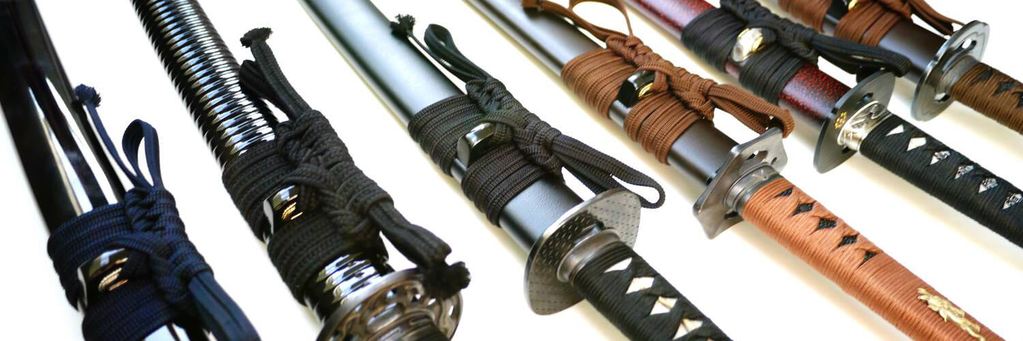
A famous braid from the 14th century was found at Saidai-ji, one of the Seven Great Temples of Nara. Originally it took two people to braid it. Photo at right shows a modern reconstruction of the pattern, braided on a takadai using 56 bobbins.
The Monoyama period (1573 – 1614) is the beginning of the kumihimo of today. It evidenced change in kimono style with the introduction of a very wide ”obi” (sash) that required a narrow cord to hold it in place. The braided ”obijime” was created for this purpose. The style is still worn in Japan today when wearing a kimono is appropriate.
Toward the end of the Edo period (1616 – 1867), the takadai, or high braiding stand, developed into its current form, one allowing for more complex, intricate patterns to be created.
Edo (later named Tokyo) became the center for kumihimo. Most of the traditional patterns that have become standard repertoire in Japanese braiding were developed during this era and the first books of patterns were published.
By the time of the Meiji period (1867 – 1912) samurai culture had declined and the wearing of armour was prohibited by law. Braidmakers suffered from the loss of samurai business, but gained new employment from the popularity of the kimono cord. They were to be heavily affected, however, by the invention of braidmaking machines and synthetic thread, which permitted production of cheaper braids. Today 95% of the obijime produced are machine-made.
Despite this, there still is a market for expensive, exclusive hand-braided products, especially for obijime.
Tea and other official ceremonies
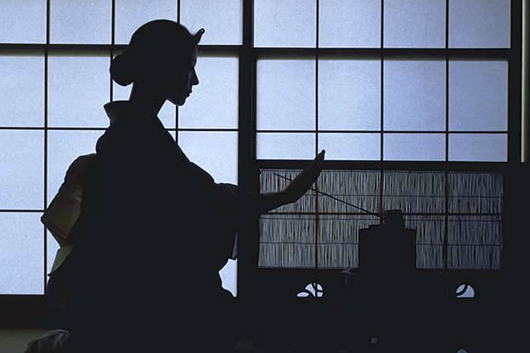
In Japan, braids are also used for religious ceremonies, ornament on festival carts, tea ceremony containers, ribbons for mirrors, fans and inro, and most recently for attaching cell phones to belts, purses, etc. (Examples in photo at right.).
Tea ceremony equipment requires elegant kumihimo for the storage containers. In former times elaborate knotting was a way to prevent the tea from being poisoned, since the knotting was difficult to re-create once it was disturbed.
The diversity of kumihimo braids
Different tools and setups can be used to create braids that are round, square, rectangular, hollow, spiral, flat, triangular and even pentagonal and half-round in cross section. Threads are held taut between weighted tama which hang from the outer edge of the kagami (mirror), and the counterweight underneath. The braid grows downward through the sloped hole in the center. In contrast, the braid grows upward on the kaku dai, where the completed portion of the braid is suspended above the tama, which are rotated to maintain the twist in the elements themselves. The karakumidai braid is strictly a twined structure, and great skill and patience is required to achieve the correct tension throughout the braid. The aya take dai is the only one of the stands to use a true weft, which is passed through sheds created by moving the tama from notch to notch on the wooden “feathers” at the front of the stand.
Taka dai braiding process is very similar to weaving, with one key difference: each element in the braid acts as both warp and weft in turn. Because the stress on the completed braid is borne by every element within the structure, it can be far stronger than a similar fabric with warp and weft. The illustration on the left below shows the path of the weft (green thread) through the warp (blue threads) in a traditional under two, over two twill fabric. Once the weft reaches the opposite edge of the warp, it returns with the same sequence, offset by one thread to create the weave. The same under two, over two sequence is used on the taka dai, but the braid is worked from the outer edge to the center. Once the thread has completed its turn as “weft”, it takes its place at the end of the row on the opposite side of the taka dai to resume the role of a warp element, as seen in the illustration on the right.
The range of structures along with the opportunities for varying fiber type, element size, element colour and colour placement offer a tremendous diversity of braids for the kumihimo enthusiast. It is this vast array of possibility that makes kumihimo such an exciting art. I invite you to explore the world of kumihimo along with me.
How to thread kumihimo
There are few ways of threading kumihimo. We won’t go much into detail and only briefly describe three most popular ways. Bear in mind that there are many more ways and tools to thread kumihimo. There is a lot of information available online, especially on Japanese websites.
1. Ayatakedai (Bamboo stand) creates flat braids, similar to those made by tablet (card) weaving. The thread bundles that are kept tightly twisted, rather than lying flat, reflect light in a different way.
2. Takadai (High stand) creates only flat braids that can be single or double layered, with very intricate patterns.
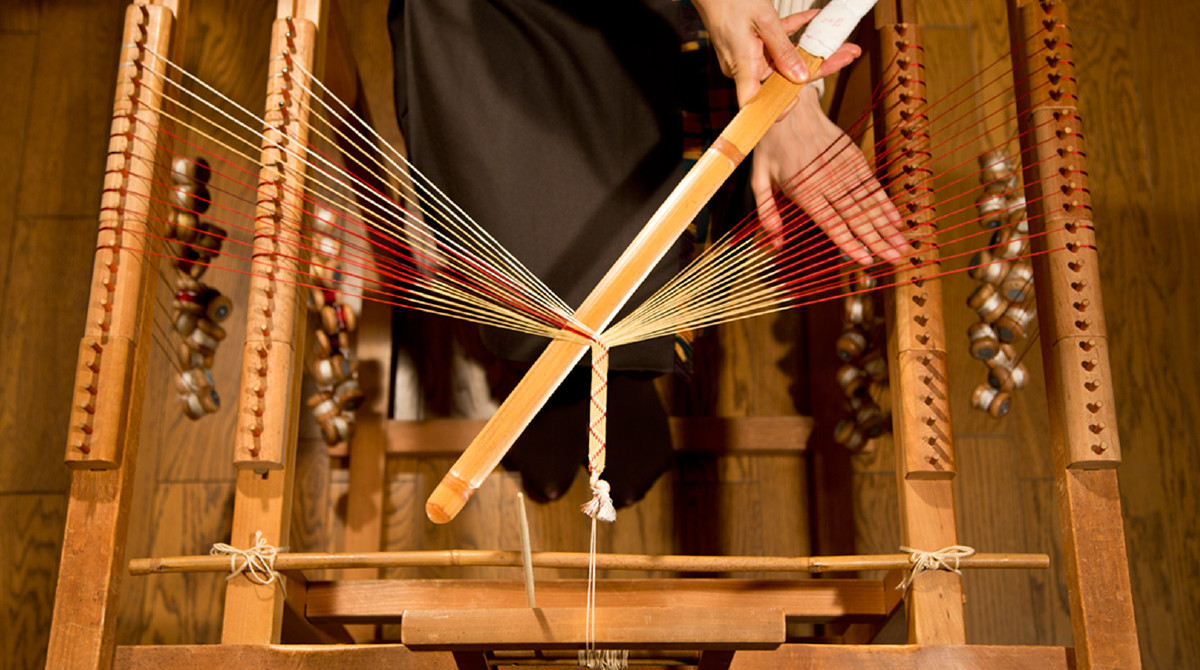
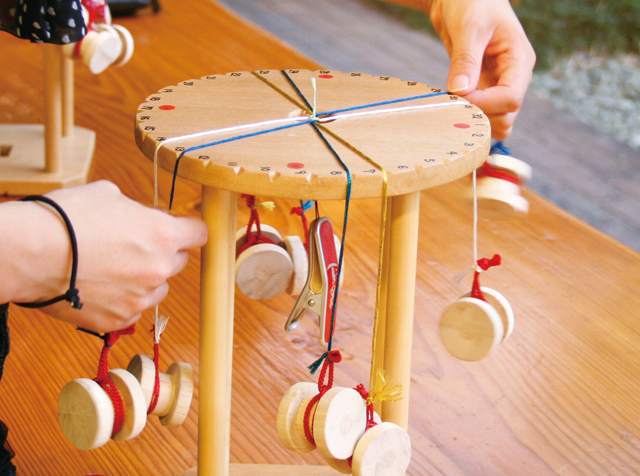
Japan wasn’t the only one
Braiding techniques have been used in many cultures throughout history worldwide. In Peru, for example, braid structures similar to the Japanese were created for centuries by the Andeans, traditionally by men who also spin. What’s more surprising, no braiding stands or equipment have been found, indicating these amazing, complex patterns were created by elaborate finger-braiding.

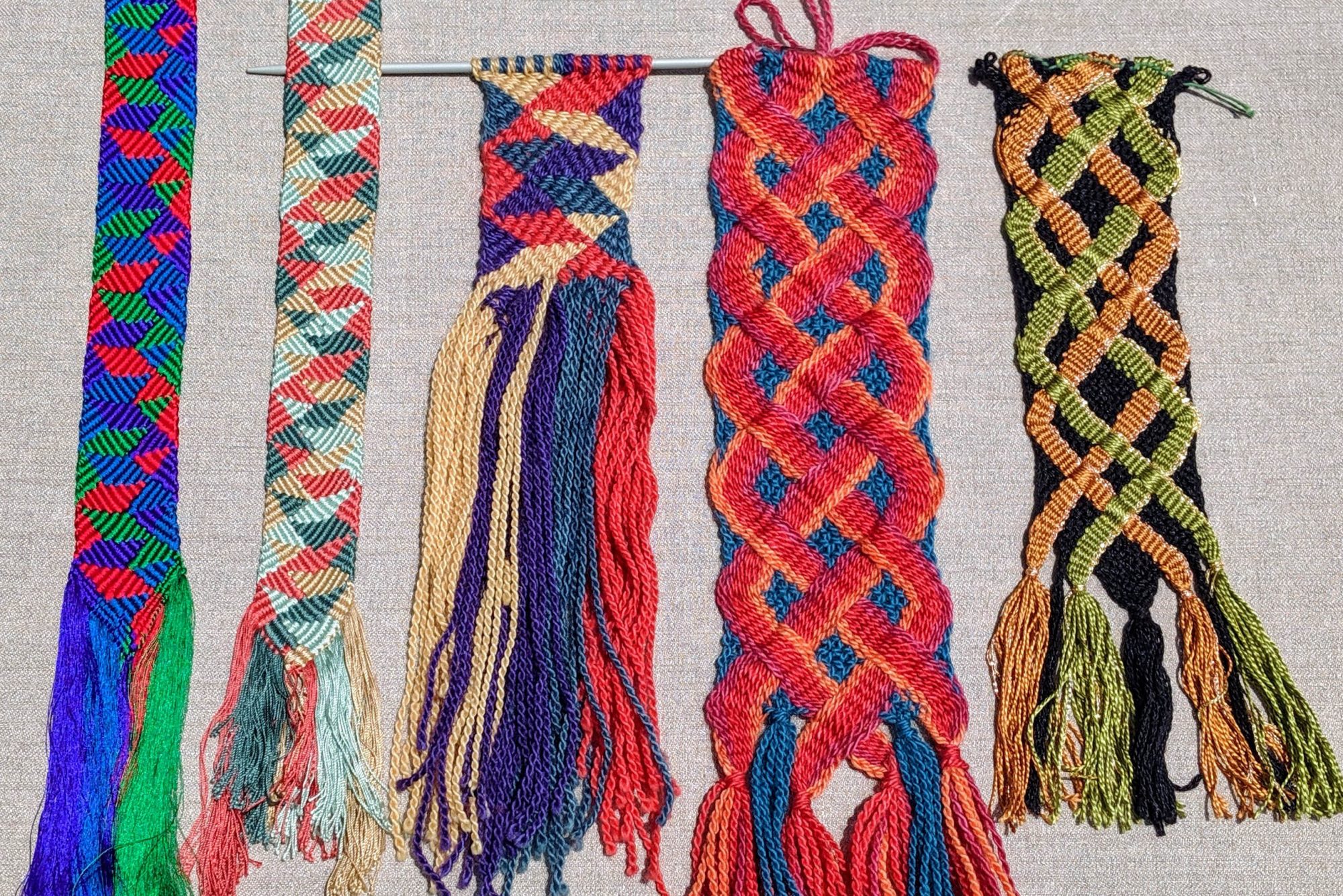
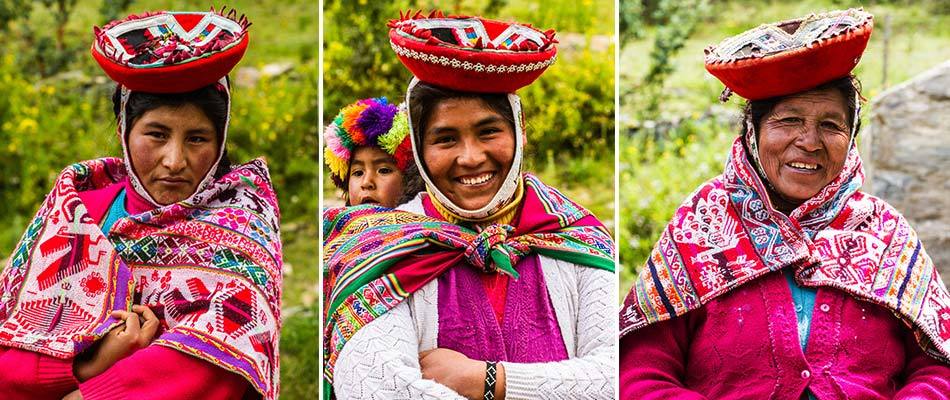
We know that the earliest braids were ‘loop manipulated’ – that is, worked with the threads looped over fingers. The braiding stands, which became so popular in Japan (shown in photos at right), most probably were developed in China or Korea. One theory traces their migration from Europe across Central Asia.
Ancient art of kumihimo
The origin of the ”Hirao” belt also can be traced to the Heian period. Made on yet another type of stand called a ”karakumidai,” it is basically a Chinese braiding technique. Only royalty – an emperor, empress, crown prince, and the three highest ranks of noblemen – were permitted to wear a Hirao. The exceptionally wide belt – 15 – 25 cm. in width; 250 cm. (8.3’) in length – is folded three times and wound around the body with the ends hanging down the front. Pictures of these belts unfortunately must not be shown
Obijime Kimono
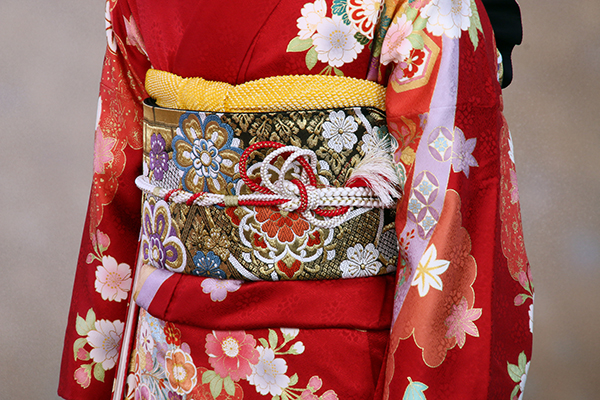
Despite this, there still is a market for expensive, exclusive hand-braided products, especially for obijime.
Despite this, there still is a market for expensive, exclusive hand-braided products, especially for obijime.
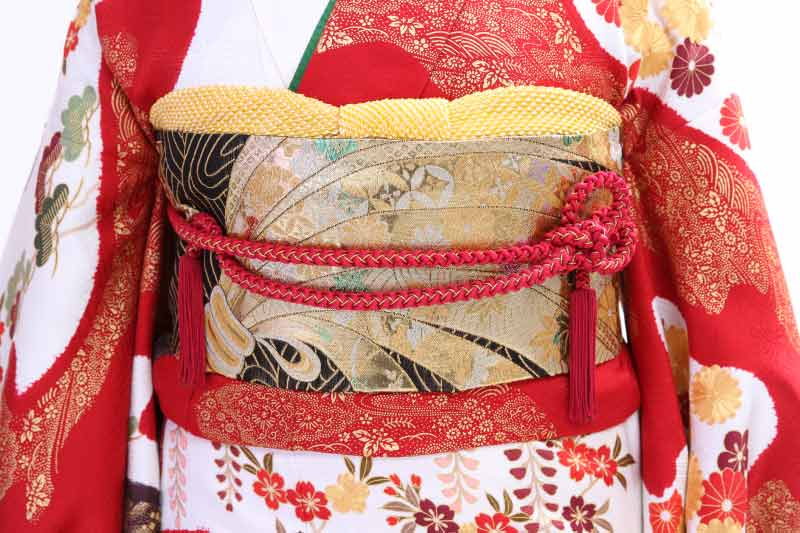
As we’ve already mentioned in the beginning of this article, from the 17th century, braiding was also used to produce articles for everyday use, including Obijime (decorative string used to hold a Kimono sash in place), Netsuke (miniature carving attached to the end of a cord hanging from a pouch), and others. While Kyoto Kumihimo (braided cords) prefers splendor, having a background of noble court society, Tokyo Kumihimo features controlled colours, showing the influence of Samurai society and townsmen culture.
Seasonal colours, reflecting the Japanese climate, provide the explosion of some of the finest patterns. Craftsmen take care to adjust the thread tightness, neither too tight nor too loose and they respect the significance of the braided meshes. Today, new braided products are being created as craftsmen adopt to the demand, including cell phone lanyards and dog leashes. Production quantities are decreasing but many people still prefer the comfortable touch of silk material, designs that fit with modern fashion trends, and the robustness of the braided articles.
Kumihimo as a competitive craft
Kumihimo is considered one of the traditional Japanese arts, though it is not as well known (even in Japan) as the tea ceremony or ikebana (flower arranging). Specialized schools have a long tradition and still attract students who want to learn the techniques for life enrichment and enjoyment purposes, rather than as income-producing employment. Usually the students are bound to their school for a lifetime.
Competition between the few remaining schools is strong. Each jealously guard their patterns and techniques. Switching from one school to another is possible only with permission of the ”sensei” (master/instructor). Instruction is firm and strict – also expensive. A certificate of course completion from a school may allow the student to teach, with strict adherence to the school’s curriculum. It also may require a ”kickback” to the school, which is common practice with many art/music schools in Japan.
For kumihimo, probably most well-known is Tokyo’s Domyo School, which at one time had a ”living national treasure” as its master. When the current Empress was Crown Princess, she was a sponsor of the school and a kumihimo enthusiast. The royal ladies-in-waiting visit the most renowned schools each year to purchase obijime for their court appearances.
Kumihimo was introduced to the Western world in the 20th century. For Europeans and Americans who wanted to study kumihimo in Japan were confronted with nearly insurmountable difficulties. The schools were reluctant to accept foreigners and for those who were allowed in, there was the language barrier. In spite of this, some were able to find open-minded Japanese teachers, who were persuaded by their seriousness. As interest grew – particularly in the 1970s – some courageous female sensei traveled to Europe and the U.S. to give instruction.
Do you have any kumihimo craft in your home?











